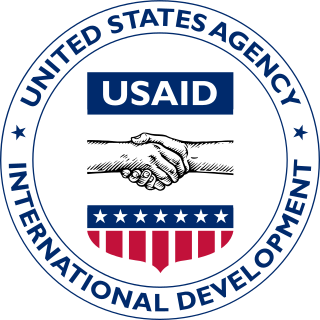
The United States Agency for International Development (USAID) is an independent agency of the United States government that is primarily responsible for administering civilian foreign aid and development assistance. With a budget of over $50 billion, USAID is one of the largest official aid agencies in the world and accounts for more than half of all U.S. foreign assistance—the highest in the world in absolute dollar terms.
Danish Committee for Aid to Afghan Refugees (DACAAR)(Danish: Den danske komité for hjælp til afghanske flygtninge) is a non-political, non-governmental, non-profit humanitarian and development organization working to improve the lives of the Afghan people since 1984.

Lashkargāh, historically called Bost or Boost, is a city in southwestern Afghanistan and the capital of Helmand Province. It is located in Lashkargah District, where the Arghandab River merges into the Helmand River. The city has a population of 201,546 as of 2006. Lashkargah is linked by major roads with Kandahar to the east, Zaranj on the border with Iran to the west, and Farah and Herat to the north-west. It is mostly very arid and desolate. However, farming does exist around the Helmand and Arghandab rivers. Bost Airport is located on the east bank of the Helmand River, five miles north of the junction of the Helmand and Arghandab rivers. Because of the trading hubs, it is Afghanistan's second largest city in size, after Kabul and before Kandahar.

DAI Global, LLC is a privately held development company with corporate offices in more than a dozen countries, including in Bethesda, Maryland, in the United States; London and Apsley, Hertfordshire, in the United Kingdom; Abuja and Lagos, in Nigeria; and Brussels, Vienna, and other European capitals.

The Kajaki Dam is "an earth and rockfill embankment type dam" located on the Helmand River in the Kajaki District of Helmand Province in Afghanistan, about 161 km (100 mi) northwest of Kandahar. It has a hydroelectric power station, which is operated by the Helmand and Arghandab Valley Authority through the Ministry of Energy and Water.
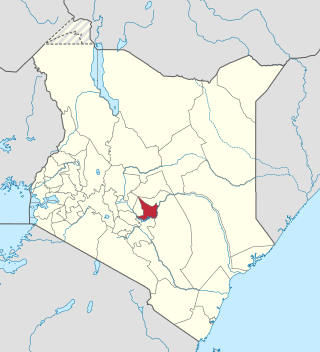
Embu County is a county of the Republic of Kenya. The capital of Embu County and the former Eastern province headquarters, Embu is a large and largely metropolitan area with a population of 608,599 persons. The county borders Kirinyaga to the west, Kitui to the east, Tharaka Nithi to the north and Machakos to the south. The county occupies an area of 2,821 km2.
Reconstruction in Afghanistan refers to the efforts to improve Afghanistan's governance as well as physical buildings and infrastructure following the overthrow of the First Islamic Emirate of Afghanistan by the United States. These efforts involved various groups including supranational organizations, the Afghan government, the US government and other foreign governments, and civilians. These efforts also include training civil administrators, improving essential services and public safety, supporting civil society and self-determination, and promoting the rule of law and economic development.
Myinmu is a river town in the south-east of the Sagaing Division in Burma. The town has a rich history linked to World War II during the Burma Campaign against the Japanese, in 1944. It was also under the control of the Portuguese Missionaries in the 19th century. One of the first agricultural cooperatives was established here in 1905.

Agriculture in Ghana consists of a variety of agricultural products and is an established economic sector, providing employment on a formal and informal basis. It is represented by the Ministry of Food and Agriculture. Ghana produces a variety of crops in various climatic zones which range from dry savanna to wet forest which run in east–west bands across Ghana. Agricultural crops, including yams, grains, cocoa, oil palms, kola nuts, and timber, form the base of agriculture in Ghana's economy. In 2013 agriculture employed 53.6% of the total labor force in Ghana.

Agriculture in Lebanon is the third most productive sector in the country after the tertiary and industrial sectors. It contributes 3.1% of GDP and 8 percent of the effective labor force. The sector includes an informal Syrian labor and is dependent on foreign labor for its productivity. Main crops include cereals, fruits and vegetables, olives, grapes, and tobacco, along with sheep and goat herding. Mineral resources are limited and are only exploited for domestic consumption. Lebanon, which has a variety of agricultural lands, from the interior plateau of the Beqaa Valley to the narrow valleys leading downward to the sea, enables farmers to grow both European and tropical crops. Tobacco and figs are grown in the south, citrus fruits and bananas along the coast, olives in the north and around the Shouf Mountains, and fruits and vegetables in the Beqaa Valley. More exotic crops include avocados, grown near Byblos, and hashish. Although the country benefits from favorable farming conditions and diverse microclimates, it relies on food imports, which make up 80% of its consumption.
Water resources management in modern Egypt, is a complex process that involves multiple stakeholders who use water for irrigation, municipal and industrial water supply, hydropower generation and navigation. In addition, the waters of the Nile support aquatic ecosystems that are threatened by abstraction and pollution. Egypt also has substantial fossil groundwater resources in the Western Desert.
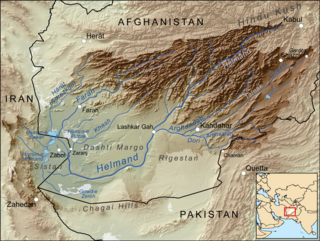
The Helmand and Arghandab Valley Authority (HAVA) based in Lashkar Gah, Afghanistan, originally named the Helmand Valley Authority (HVA) until its expansion in 1965, was established on December 4, 1952, as an agency of the Afghan Government. The agency was modeled on the Tennessee Valley Authority in the United States, with a remit covering lands in Farah Province, Ghazni Province, Helmand Province, Herat Province, and Kandahar Province.

Bihsud District is a district of Nangarhar Province, Afghanistan. The district, which contains 40 main villages, is located around the city Jalalabad, spanning both sides of the Kabul River. The district was previously a unit which contained the city of Jalalabad, but in 2004 the city became independently administered under the municipality system, and the portions of the district not contained within the city became Bihsud District. Oranges, rice, and sugarcane grow in the fertile district, and the capital city has cane-processing and sugar-refining as well as papermaking industries. The district's year-round summery weather attracts many visitors.
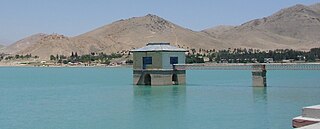
Qargha Dam is located in the town of Qargha, about 10 mi (16 km) west from the Shahr-e Naw neighborhood of Kabul, Afghanistan. It is an embankment dam built on the Paghman River, with a side channel spillway under the road running on top of the dam. Its reservoir can hold up to 12,000,000 m3 (420,000,000 cu ft) of water, which is used for irrigation purposes. The dam is named after the town.
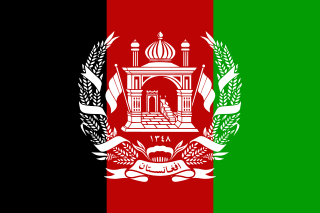
Water supply in Afghanistan is managed by the National Water Affairs Regulation Authority (NWARA), which is based in Kabul, Afghanistan. The nation's water supply is characterized by a number of achievements and challenges. Among the achievements are:
International Relief and Development, Inc. (IRD), renamed Blumont, is an organization that purports to provide relief, stabilization, and development programs worldwide. In 2015, IRD was the subject of a Washington Post investigation that highlighted the organization's performance and management of taxpayer money. Among other irregularities, the organization had charged the US Government $1.1 million for staff parties and retreats at exclusive resorts. In January 2016, IRD announced that it was changing its name to Blumont and relocating to Madison, Wisconsin.
The Mae Fah Luang Foundation (MFLF) is a private, non‐profit organization established to improve the quality of life of people in poverty and deprived of opportunities. It manages numerous projects in Thailand as well as other countries in Asia. The foundation's mission focuses on three main areas: “improving social and economic development, preserving the environment, and supporting local art and culture.”
Chemonics International, Inc. is a private international development firm based in Washington, D.C. It was established in 1975 by Thurston F. (Tony) Teele as a subsidiary of Erly Industries. The employee-owned company offers a variety of services globally and with more than $1.5 billion in USAID contracts in 2019 is the largest for-profit recipient of U.S. government foreign aid. As of 2019 the company has approximately 5,000 employees in 100 countries.

Almond production in Afghanistan is a significant contributor to the nation's agricultural economy. In 2009, it was ranked ninth in the FAO list of almond-producing countries of the world, though its domestic production is limited to 2% of the world production. Afghanistan's almond production has shown a rising trend in the recent decades. Within the country, the southwestern and northern regions have the maximum area under cultivation with Kandahar and Samangan provinces, accounting for much of its production, followed by the provinces of Uruzgan, Kunduz, Balkh, Saripul and Daykundi. As of 2012, the cultivated area of almonds was 13,490 ha with a yield rate of 45,960 hectograms per ha, recording a total yield of 62,000 tonnes, with conducive climatic conditions for growing variety of almond landraces of hard shell and soft shell varieties. The preferred markets for the export of Afghan almonds are India and Pakistan, with the former preferred because of better profitability.
Foreign aid for gender equality in Jordan includes programs funded by governments or non-governmental organizations (NGOs) that aim to empower women, close gender based gaps in opportunity and experience, and promote equal access to education, economic empowerment, and political representation in the Hashemite Kingdom of Jordan.











